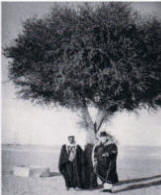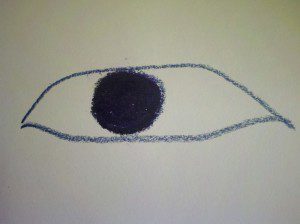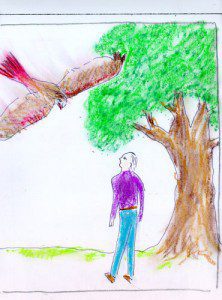
He lived with his large and imposing wife Violet in a blue and white house overlooking the Gulf, with a verandah on the upper level to catch the sea breezes. Under the fierce desert sun, he went shooting in gaiters and country tweeds, and may have looked, in his florid bulk, the model of the type of colonial Englishman who does not go native.
But Colonel H.R.P. (Harold) Dickson was very far from a stereotype. Born in what is now Syria, he was Bedouin as well as British – in the eyes of that desert people – from the time he suckled at the breast of a Bedouin wet nurse. As he rose high in the ranks of the colonial civil service, becoming British Political Agent in Kuwait from 1929 to 1936, he hunted with the Bedouin, and counseled with them over innumerable cups of cardamom-flavored coffee, and dreamed like them.
On at least two occasions before his retirement, he brought the Sheikh of Kuwait prophetic dreams. One forewarned of a natural disaster that would destroy much of the capital but result in abundance. It was fulfilled when storm and flood washed away thousands of mudbrick houses, and then made the desert bloom. In the second dream, Dickson foresaw an attempt on the life of the king of Saudi Arabia. When the assassination attempt took place, his prowess as a prophetic dreamer was confirmed. “The Sheikh of Kuwait marveled still more, and told my story to many of his friends,” he recalled in his book The Arab of the Desert.. “The story got about and my stock went up quite appreciably inKuwait. My dreams are still given proper weight, but I am careful not to give too much away.”
The Sheikh urged him to stay on inKuwaitafter he retired from the colonial service, and he continued to live and to dream in his blue and white house as Chief Local Representative of the Kuwait Oil Company.
In September 1937, the Kuwait Oil Company was drilling at a lonely place called Bahra, and work was not going well. They had probed far deeper than they had intended, and fond no trace of oil.
That month, Dickson dreamed that he and his wife were living in a bungalow in an oil camp in the heart of the desert. Nothing was growing in the scene except an immense ancient sidr tree, standing near the house. A wild wind blew up a sand storm of unusual violence. It shook the house and the grains in the air made it hard to breathe. When the storm abated, Dickson went out and saw that the storm had opened a great cavity under the tree. He looked down into what appeared to be an ancient tomb. A prone figure, shrouded in rotted yellow cotton cloth, lay on a stone slab.
When Dickson and his wife began to peel the ruined cloth away from the mummy’s head, they were surprised by the beauty of the young woman’s face that was revealed. Her skin was like parchment. Dickson called for his servants to dig a fresh grave, but to his amazement the mummy came alive. The parchment skin grew soft and smooth, and a lovely woman stepped free from her shrouds. She told the Dicksons she was cold, after sleeping for thousands of years, and needed food and warm clothes. She gave them a very ancient copper coin. They led her by the hand into the house, where their Arab maid washed her and dressed her while they prepared food.
After eating, the woman from the tomb sat under the sidr tree. She warned that “wicked men” would try to bury her again, and that Dickson must seek the aid of the Sheikh and the British government. As she spoke, a mob of angry men, brandishing weapons, appeared. They were led by a white-bearded man armed with a long knife “who looked like a Persian”. Colonel Dickson flew to the defense, killing the leader with a blow, and driving off the men who were digging a fresh grave. He took the girl back inside his bungalow.
Waking in high excitement, Dickson roused his wife Violet and she carefully recorded all the details of his dream. This was a regular procedure in the Dickson household; he felt this one augured immense good fortune.
But it was necessary to find out exactly what was going on in the dream. For this, Dickson sought counsel from a local expert, a Bedouin woman called Umm Mubarak, who was much respected as a diviner and reader of dreams. The sand devil that opened the mummy’s tomb might be a djinn – a desert demon. It might also be a drilling rig. Umm Mubarak sifted the elements of the dream, and gave Dickson her judgment. The mummy that came alive and gave him treasure from the earth was showing the way to a fabulous oil field that had not yet been discovered. The ancient tree, growing alone in the desert, gave away the location. Umm Mubarak had seen this tree; it had survived alone in a waste of sand in the Burqan hills. The angry mob consisted of people in the region who would oppose Western oil operations.
Dickson told his dream to the Sheikh of Kuwait, who heard him with great respect. He told the managers f the Kuwait Oil Company that they should move their drilling operations to Burqan. The oil company followed Dickson’s advice, and early in 1938 they hit a gusher. The find – known as Burqan Number One – was one of the richest oil discoveries in history. It was a great coup for the British in those edgy months on the eve of World War II. It turnedKuwait into a fabulously wealthy country, tempting Saddam Hussein, more than half a century later, to launch the invasion that triggered the first Gulf War.
Adapted from The Secret History of Dreaming by Robert Moss. Published by New World Library.

